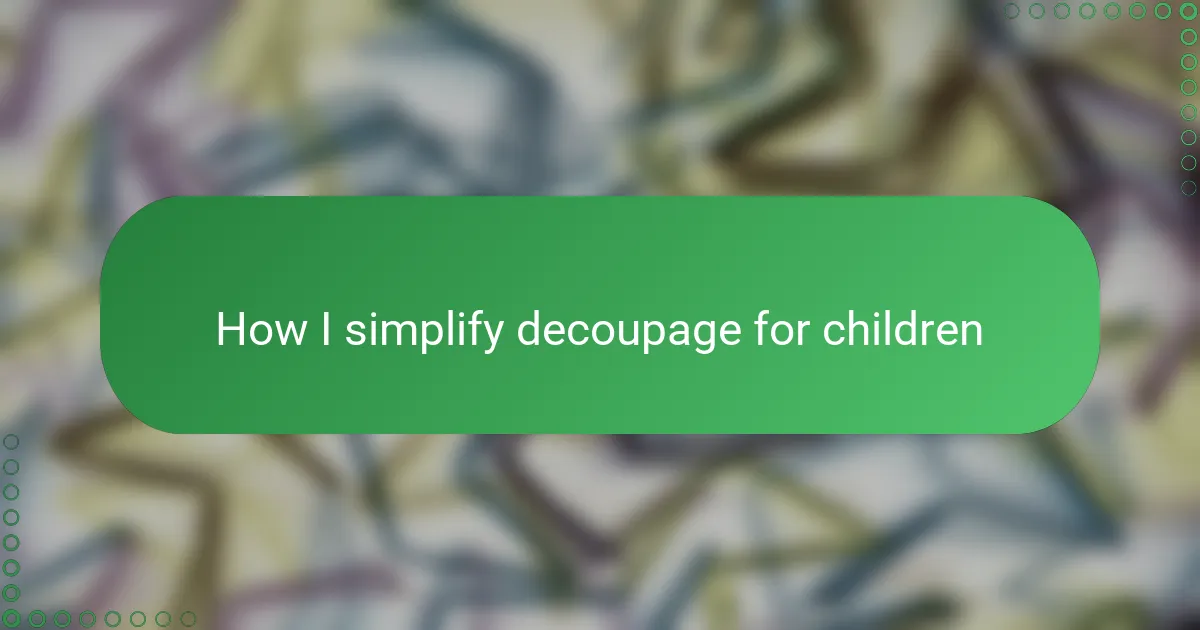Key takeaways
- Decoupage is a creative and engaging craft that enhances children’s focus and self-expression through the process of cutting, gluing, and layering paper.
- Essential materials for kids include child-safe glue, safety scissors, and lightweight papers, encouraging hands-on creativity without overwhelming them.
- Simple projects, like decorating bookmarks and gift tags, help children enjoy crafting while practicing important skills in a manageable way.
- Encouraging a positive and open-ended creative environment boosts children’s confidence, allowing for exploration and personal expression.

What is decoupage crafting
Decoupage crafting is the art of decorating objects by gluing paper cutouts onto them and then sealing the surface with varnish or glue. It seems simple, but when I first tried it with kids, I realized it’s a wonderful way to transform everyday items into personalized treasures. Have you ever noticed how cutting and arranging paper pieces sparks creativity in children?
What I find fascinating about decoupage is how it combines basic skills—cutting, gluing, and layering—into something visually stunning without needing fancy tools or techniques. It turns crafting into storytelling, as each paper piece can represent a memory, a theme, or just something colorful that catches the eye. From my experience, this hands-on process is perfect for engaging children’s focus and encouraging self-expression.
Sometimes I wonder why more people don’t explore decoupage with kids. Maybe it’s because it seems too precise or delicate, but actually, the beauty lies in imperfections and personal touches. The tactile nature of handling different papers makes it approachable, and watching kids’ faces light up when their project comes together is always priceless.

Essential materials for kids decoupage
When I first introduced decoupage to kids, I made sure to keep the materials simple and safe. Essentials like child-friendly glue sticks or watered-down white glue, safety scissors, and colorful paper scraps became our go-to supplies. Have you noticed how just the thrill of picking out paper patterns can make little hands eager to create?
I always recommend starting with lightweight paper, like tissue or scrapbooking paper, because it’s easier for children to cut and shape. From my experience, using a soft brush to spread glue helps kids avoid mess and feel more in control during the layering process. It’s amazing how these basic materials turn into tools of imagination in a child’s hands.
What truly stands out to me is how these simple supplies encourage focus without overwhelming little crafters. I’ve seen shy kids transform into confident artists just by experimenting with glue and paper. The key is having the right materials—not too many, just enough to inspire creativity and keep frustration at bay.

Step by step decoupage techniques
Getting the steps right makes all the difference in simplifying decoupage for children. I usually start by encouraging kids to choose and cut their paper pieces first, letting them enjoy the tactile joy of handling different textures. Do you know how empowering it feels for a child to see their carefully cut shapes ready to transform an ordinary item?
Next comes the gluing process, which I break down into small, manageable actions. I remind them to brush a thin layer of glue gently onto the surface, then carefully place the paper without rushing—this slow and steady approach really helps maintain their focus. Sometimes, I notice that kids want to skip steps, but slowing down actually turns the task into a calming, almost meditative experience.
Finally, sealing the project with a protective coat is like the magic touch that brings everything together. Whenever I involve kids in spreading this layer, I see their eyes light up as their designs take on a glossy finish—it’s a rewarding moment that celebrates both patience and creativity. Have you ever watched a child beam with pride after seeing their work transformed by that last brushstroke?

Choosing safe glue for children
Choosing the right glue for kids is more than just a safety checklist—it’s about making sure their creative experience feels fun and worry-free. I always opt for non-toxic, water-based glues because they’re gentle on little fingers and easy to clean up. Have you ever seen a child’s face light up when they realize glue isn’t going to turn the craft session into a sticky disaster?
From my experience, glue sticks can be a game-changer for young crafters. They’re less messy, simple to handle, and allow kids to focus more on placing their paper pieces rather than wrestling with wet glue. I remember one shy child who gained so much confidence just by mastering the glue stick; it was a small victory that made the whole project more enjoyable.
It’s also important to avoid strong-smelling or chemical-heavy adhesives that can overwhelm sensitive noses and disrupt the creative flow. I usually keep a jar of diluted white glue handy—safe, effective, and something I know from experience won’t cause any worries. Isn’t it amazing how a little consideration for safety can turn crafting into such a positive, memorable adventure for children?

Simple projects for young crafters
Simple projects with clear, manageable steps truly make decoupage accessible for young crafters. I’ve seen firsthand how starting with familiar items—like plain boxes or old notebooks—gives children instant joy when they watch their favorite paper designs come to life on these everyday objects. Isn’t it amazing how a simple project can hold a child’s attention for an entire afternoon?
One project I often suggest is decorating bookmarks using colorful scraps and stickers. It’s small-scale, so kids don’t feel overwhelmed, yet there’s plenty of room for creativity. I’ve noticed that this size allows even the youngest hands to practice precise cutting and gluing skills without frustration.
Sometimes, I encourage kids to make personalized gift tags for family members; this project feels special because it connects crafting with giving. Watching a child proudly hand over a handmade tag always reminds me why simple, meaningful projects are best—they celebrate creativity and kindness at the same time.

Tips to encourage creativity in children
Encouraging creativity in children often means giving them the freedom to explore without fear of making mistakes. I’ve found that when I tell kids it’s okay for their designs to be imperfect, their confidence soars—and suddenly their ideas flow more freely. Have you ever noticed how a little reassurance can open the door to so much imagination?
Another tip I lean on is to ask open-ended questions during crafting, like “What story do you want your project to tell?” or “How would you change this if you could?” These questions invite kids to think beyond the task itself and connect emotionally with their work. From my experience, this turns a simple craft into a meaningful adventure.
Finally, I make it a point to celebrate every creative choice, no matter how small. Praising a thoughtful color mix or a clever paper arrangement shows children that their unique vision matters. Doesn’t it feel rewarding to see a child’s face light up when you truly notice their creativity? I can tell you, those moments are what keep me coming back to handmade paper crafts time and again.

Troubleshooting common decoupage issues
Sometimes, the paper wrinkles or bubbles when kids apply glue too thickly. I always remind little crafters to use a thin, even layer of glue—it’s amazing how this simple tip changes the whole look of their project. Have you ever noticed how a smooth surface makes their designs look so much neater and more magical?
Peeling edges can be frustrating, especially for young hands. From my experience, encouraging kids to gently press down each paper piece and let it dry completely before adding a sealing coat really helps. I remember one child who proudly kept checking their work, thrilled to see those edges stay perfectly flat.
And then there’s the ever-popular sticky mess—sometimes glue gets where it shouldn’t! I keep damp cloths nearby and teach kids not to panic but to gently wipe excess glue while it’s still wet. This little habit turns tricky moments into learning opportunities, and suddenly crafting feels less like a chore and more like a fun challenge.
